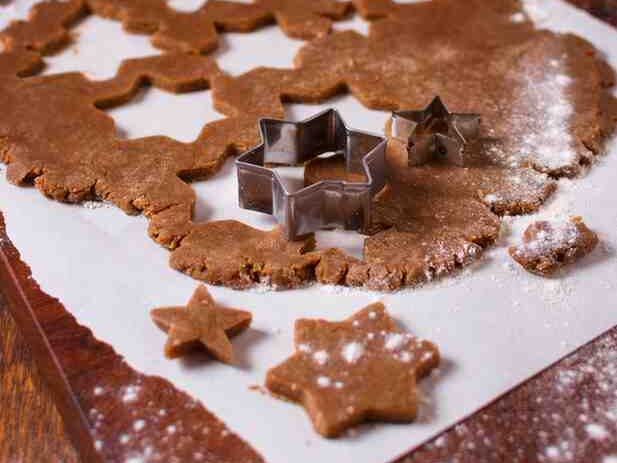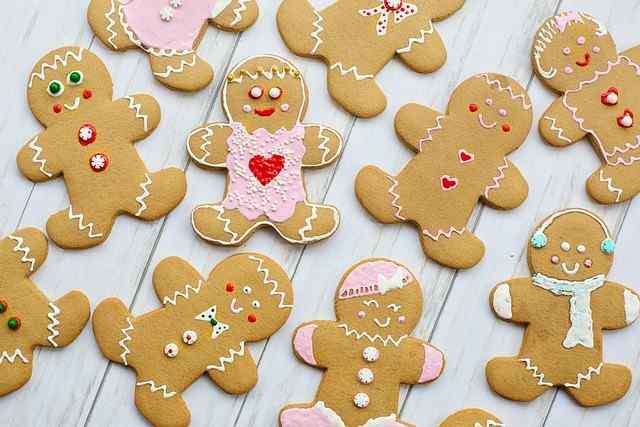Gingerbread, one of the most enduring and beloved treats, has a history that spans centuries and continents. Its earliest forms date back to ancient civilizations like Greece and Egypt, where spiced doughs were used in ceremonial offerings. Over time, the concept of sweetened, spiced bread evolved into the cookies we know and love today.
Early Beginnings:
- Ancient Greece and Egypt: These cultures created dense spiced breads as offerings in religious rituals.
- China and the Silk Road: The spread of ginger from Asia introduced its use in baked goods across Europe.
- The Middle Ages: European bakers began experimenting with gingerbread, blending spices like ginger, cinnamon, and cloves to create bold flavors.
By the 11th century, gingerbread had become a staple in European monasteries, often used to craft intricate designs and figures for festivals.
Gingerbread and European Royalty
The popularity of gingerbread skyrocketed during the reign of Queen Elizabeth I. She famously commissioned gingerbread cookies shaped like her court members and visiting dignitaries. This gesture not only showcased her creativity but also cemented gingerbread’s status as an artistic and festive treat.
Royal and Cultural Influence:
- Queen Elizabeth I’s Contribution: The tradition of decorating gingerbread figures started in her court.
- Germany’s Lebkuchen: In the 16th century, German bakers created softer, heart-shaped gingerbread, which became a symbol of love and celebration.
- France and Poland: Both countries developed regional versions of gingerbread, often shaped into intricate patterns and used as ornaments.
The association of gingerbread with royalty made it a luxury item, often reserved for special occasions like Christmas and weddings.
The Rise of Gingerbread Cookies in America
Gingerbread made its way to America with European settlers. Over time, the recipes were adapted to include molasses, which was more affordable and readily available than honey. The result was a darker, richer flavor that became distinctly American.
American Gingerbread Traditions:
- Gingerbread Men: Popularized in the 19th century, these cookies became a family favorite for holiday gatherings.
- Gingerbread Houses: Inspired by the Brothers Grimm fairy tale Hansel and Gretel, building gingerbread houses became a cherished holiday activity in the U.S.
These traditions remain central to Christmas celebrations, symbolizing warmth, creativity, and togetherness.

The Essential Ingredients of Gingerbread Cookies
The signature flavor of gingerbread cookies comes from their unique blend of spices and sweeteners. Each ingredient plays a specific role in creating the iconic taste and texture.
Core Ingredients:
- Ginger: The defining spice, adding warmth and a slight bite.
- Molasses: Provides a rich, caramel-like sweetness and dark color.
- Cinnamon: Enhances the sweetness with aromatic depth.
- Cloves: Adds earthiness and a subtle bitterness that balances the sweetness.
- Nutmeg: Contributes a nutty, spicy flavor that ties everything together.
Baking Science:
- Flour: Provides the structure for the cookies.
- Butter: Adds richness and a tender texture.
- Baking Soda: Helps the dough rise slightly, creating a soft but sturdy cookie.
How Gingerbread Became a Holiday Icon
Gingerbread cookies became synonymous with Christmas during the 17th century, particularly in Germany. Their warm, spiced aroma and intricate decorations made them a perfect fit for festive celebrations.
Holiday Traditions:
- Gingerbread Markets: German Christmas markets often featured stalls selling Lebkuchen.
- Decorated Cookies: By the 19th century, gingerbread cookies were shaped into stars, trees, and other holiday-themed designs.
- Family Bonding: Decorating gingerbread cookies became a cherished family activity during the holiday season.
Today, gingerbread cookies are enjoyed worldwide, symbolizing joy, creativity, and the spirit of giving.
Traditional Gingerbread Cookie Recipe
Ingredients:
- 3 cups all-purpose flour
- 1 tsp baking soda
- ½ tsp salt
- 1 tbsp ground ginger
- 1 tsp cinnamon
- ½ tsp ground cloves
- ½ tsp nutmeg
- ¾ cup unsalted butter, softened
- ¾ cup brown sugar
- 1 large egg
- ½ cup molasses
- 1 tsp vanilla extract
Instructions:
- Prepare the Dry Ingredients: In a medium bowl, whisk together flour, baking soda, salt, and spices.
- Cream Butter and Sugar: Beat softened butter and brown sugar in a separate bowl until light and fluffy.
- Incorporate Wet Ingredients: Add the egg, molasses, and vanilla to the butter mixture, mixing until well combined.
- Form the Dough: Gradually add the dry ingredients to the wet mixture, stirring until a dough forms.
- Chill the Dough: Wrap the dough in plastic wrap and refrigerate for at least 1 hour.
- Roll and Cut: Roll the dough on a floured surface to about ¼-inch thickness. Use cookie cutters to create desired shapes.
- Bake: Preheat the oven to 180°C (350°F) and bake the cookies on a parchment-lined sheet for 8–10 minutes.
Decorating Gingerbread Cookies
The fun doesn’t stop at baking—decorating gingerbread cookies is where creativity shines. Whether you prefer a minimalist approach or intricate designs, the possibilities are endless.
Decorating Ideas:
- Royal Icing: Pipe delicate patterns using white or colored icing.
- Candy Accents: Use small candies to add eyes, buttons, or other details.
- Sprinkles: Add a festive touch with colored sprinkles.
- Chocolate Drizzle: Melt dark or white chocolate for a luxurious finish.
Tips for Success:
- Let cookies cool completely before decorating.
- Use fine-tipped piping bags for precise details.
- Mix and match decorations to create unique themes.
Decorating gingerbread cookies is a perfect way to bring family and friends together during the holidays.

Fun Facts About Gingerbread Cookies
- World Records: The largest gingerbread house ever made measured over 39,000 cubic feet!
- Spiced Health: Ginger was historically valued for its medicinal properties, including aiding digestion and reducing inflammation.
- Symbolism: In some cultures, gifting gingerbread symbolizes love and good luck.
The Cultural Evolution of Gingerbread
As gingerbread cookies gained popularity across Europe and beyond, they evolved to reflect the customs and tastes of each region. Their intricate designs and flavors quickly became symbols of celebration and creativity.
From Europe to the World
- Germany’s Lebkuchen: Known for its softer texture, Lebkuchen became a favorite at German Christmas markets. These cookies often featured intricate patterns, turning them into edible art.
- Swedish Pepparkakor: Thin and crispy, pepparkakor are often cut into heart shapes and hung as decorations during the holiday season.
- American Gingerbread Houses: Inspired by the Brothers Grimm’s Hansel and Gretel, building gingerbread houses became a popular family activity in the United States.
Consequently, gingerbread became more than just a treat—it transformed into a symbol of tradition and festive cheer across the globe.
Modern Traditions with Gingerbread
Today, gingerbread cookies are closely associated with the holiday season. However, their uses and presentations have expanded, making them a part of various celebrations and creative endeavors.
Decorating as a Family Tradition
- Bonding Time: Families often come together to bake and decorate gingerbread cookies, making it a cherished holiday ritual.
- Creative Expression: From simple icing patterns to elaborate designs, decorating gingerbread cookies provides a chance to showcase creativity.
- Gift-Giving: Beautifully decorated gingerbread cookies are often packaged and gifted as thoughtful, homemade presents.
Additionally, schools and community centers frequently organize gingerbread decorating events, fostering a sense of togetherness.
Building Gingerbread Houses
While gingerbread cookies are delightful on their own, building gingerbread houses has become an iconic tradition, especially during Christmas. This activity blends baking with architecture, creating a fun and memorable experience.
Tips for Building a Gingerbread House
- Choose a Sturdy Dough: Use a slightly firmer gingerbread recipe to ensure the walls and roof hold their shape.
- Use Royal Icing as Glue: Royal icing hardens as it dries, making it ideal for assembling the structure.
- Plan Your Design: Sketch the layout of the house beforehand to simplify the building process.
- Decorate Before Assembly: Adding details like candy windows or piped designs is easier when the pieces are flat.
By following these tips, you can create a stunning gingerbread house that becomes the centerpiece of your holiday decorations.
Fun Gingerbread Variations
While traditional gingerbread cookies remain a favorite, modern bakers have experimented with new flavors and presentations. These variations keep the treat exciting and relevant for different occasions.
Popular Variations:
- Chocolate Gingerbread Cookies: Adding cocoa powder to the dough results in a richer, chocolate-infused flavor.
- Vegan Gingerbread Cookies: Substitute butter with plant-based margarine and use a flaxseed mixture as an egg replacement.
- Spiced Gingerbread Bars: Bake the dough in a tray and cut it into bars for a chewy, cake-like texture.
- Gingerbread Sandwich Cookies: Fill two cookies with cream cheese frosting or chocolate ganache for a decadent treat.
These creative twists allow gingerbread lovers to explore new tastes while still enjoying the classic spices they adore.
Pairing Gingerbread Cookies with Beverages
Gingerbread cookies pair wonderfully with a variety of beverages, enhancing their flavors and providing a cozy culinary experience.
Classic Pairings:
- Hot Chocolate: The creamy sweetness of hot chocolate complements the spices in gingerbread cookies.
- Mulled Wine: This warm, spiced drink enhances the cookie’s cinnamon and ginger notes.
- Coffee or Espresso: A bold coffee contrasts the sweetness of the cookies, creating a balanced flavor profile.
- Milk: A simple glass of milk adds a comforting touch, especially for children.
As a result, serving gingerbread cookies with the right beverage elevates the overall experience and makes every bite more enjoyable.
Trends and Innovations in Gingerbread
With evolving culinary trends, gingerbread has seen creative transformations that cater to modern tastes and preferences.
Popular Innovations:
- Health-Conscious Recipes: Bakers now create gluten-free and sugar-free gingerbread cookies, appealing to those with dietary restrictions.
- Edible Gingerbread Ornaments: Gingerbread cookies are often used as festive decorations on Christmas trees.
- Fusion Flavors: Combining traditional gingerbread spices with flavors like matcha, cardamom, or orange zest introduces exciting variations.
- Interactive Gingerbread Kits: Pre-baked gingerbread house kits allow families to focus on decorating without the hassle of baking.
These innovations ensure gingerbread remains relevant and exciting for both traditionalists and modern food enthusiasts.
Final Tips for Perfect Gingerbread Cookies
Whether you’re baking gingerbread cookies for the first time or have been doing it for years, a few extra tips can help you achieve the best results.
Key Takeaways:
- Use Fresh Spices: Old spices can lose their potency, so always use fresh ginger, cinnamon, and cloves for the most vibrant flavors.
- Chill the Dough: Refrigerating the dough before rolling makes it easier to handle and prevents the cookies from spreading during baking.
- Don’t Overbake: Gingerbread cookies should be slightly soft when removed from the oven, as they firm up while cooling.

